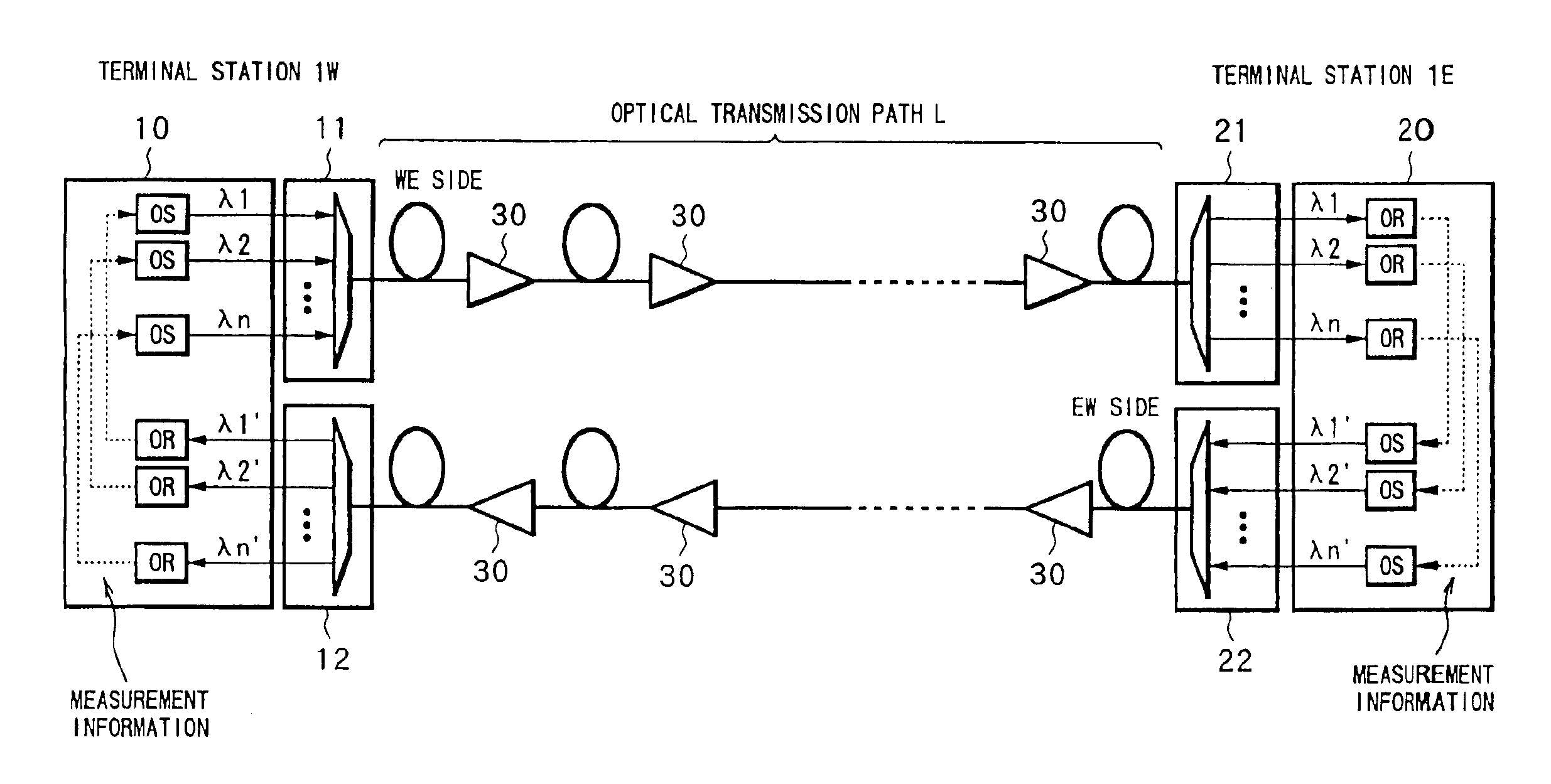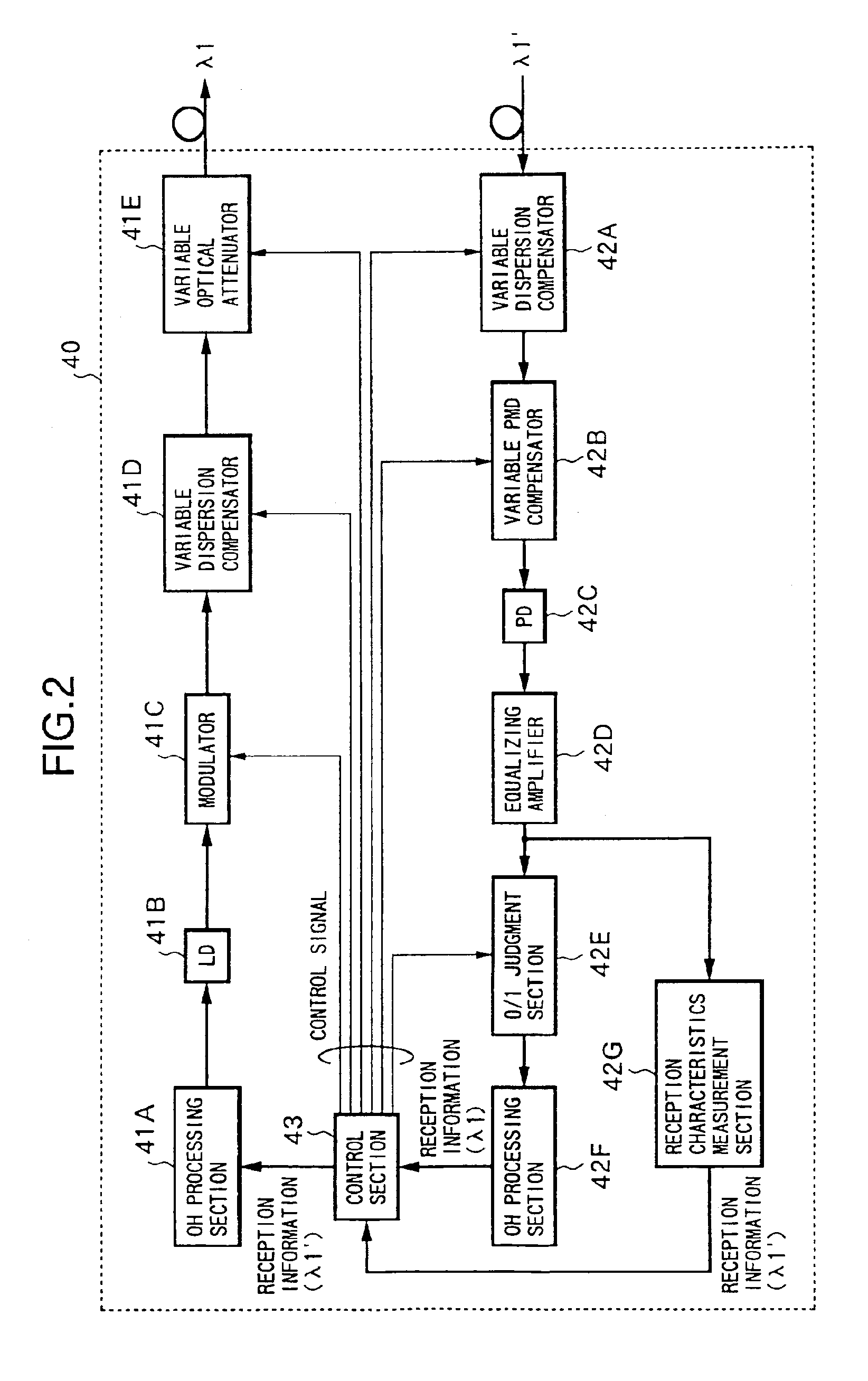Wavelength division multiplexing optical communication system and wavelength division multiplexing optical communication method
- Summary
- Abstract
- Description
- Claims
- Application Information
AI Technical Summary
Benefits of technology
Problems solved by technology
Method used
Image
Examples
first embodiment
[0037]FIG. 1 shows a structure of a WDM optical communication system according to a
[0038]In FIG. 1, the construction of the present WDM optical communication system is, for example, that two transmitting-receiving terminal stations, 1W and 1E, are connected by an optical transmission path L comprising two lines of opposing transmission directions. Here, the line that transmits WDM signal light from the terminal station 1W to the terminal station 1E is designated the WE line, and the line that transmits from the terminal station 1E to the terminal station 1W is designated the EW line. In both the WE line and the EW line, a plurality of optical amplifiers (optical repeaters) 30 are arranged at required repeater spacing. A system constructed like this is suitable for a land WDM optical communication system.
[0039]The terminal station 1W, for example, has a transmitter-receiver 10 and WDM apparatuses 11 and 12. The transmitter-receiver 10 transmits respective optical signals of wavelengt...
second embodiment
[0078]Next is a description of a
[0079]In the first embodiment mentioned above, the construction is such that the reception information of the OSNR and BER obtained at the receiving end is superimposed on the overhead information of the optical signal transmitted on the opposing line, and forwarded to the transmitting end. However in the second embodiment, a case is considered where the reception information of the OSNR and BER is transmitted on an optical supervisory channel (OSC), so that the operating conditions of the WDM apparatus inside the station, the optical amplifiers arranged on the optical transmission path L, and the like can be controlled depending on the OSNR and BER.
[0080]FIG. 5 shows the structure of a WDM optical communication system according to the second embodiment. Here, the same symbols are used for the same structures as in the first embodiment, and this is the same hereunder.
[0081]In FIG. 5, the point of difference in the structure of the present WDM optical ...
third embodiment
[0101]Next is a description of the present invention.
[0102]FIG. 10 shows a structure of a WDM optical communication system according to the third embodiment.
[0103]In FIG. 10, the construction of the present WDM optical communication system is, similarly to the case in the first embodiment, for example that the two transmitter-receiver terminal stations, 100W and 100E, are connected by an optical transmission path L comprising two lines (WE side and EW side) of opposing transmission directions. In each line, a plurality of optical repeaters 130 is arranged at required repeater spacing. A system constructed as described hereunder is suitable, for example for a seabed WDM optical communication system.
[0104]The terminal station 100W has, for example, an optical transmitting section 101S and an optical receiving section 101R. The WDM signal light of wavelengths λ1˜λn, which is generated in the optical transmitting section 101S, is transmitted to the WE line of the optical transmission pa...
PUM
 Login to View More
Login to View More Abstract
Description
Claims
Application Information
 Login to View More
Login to View More - R&D
- Intellectual Property
- Life Sciences
- Materials
- Tech Scout
- Unparalleled Data Quality
- Higher Quality Content
- 60% Fewer Hallucinations
Browse by: Latest US Patents, China's latest patents, Technical Efficacy Thesaurus, Application Domain, Technology Topic, Popular Technical Reports.
© 2025 PatSnap. All rights reserved.Legal|Privacy policy|Modern Slavery Act Transparency Statement|Sitemap|About US| Contact US: help@patsnap.com



